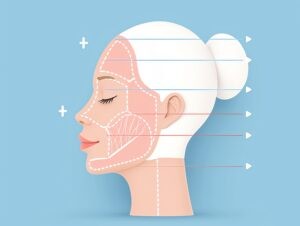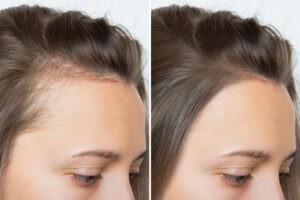
The term “Ozempic Face” has been making headlines, often sparking concern among those using Ozempic—a medication initially developed for managing Type 2 diabetes and now widely used for weight loss. But what exactly is Ozempic Face? And is it as inevitable or irreversible as some claim?
Let’s break down the myths, examine the science behind these facial changes, and explore practical solutions to address them.
What’s All This Talk About “Ozempic Face”?
Ozempic Face describes the changes in facial appearance some people notice after rapid weight loss. This might include a gaunter look, sagging skin, or reduced facial volume. While it’s named after Ozempic, it’s crucial to understand that these effects are not caused by the medication itself but rather by the way rapid weight loss can impact fat distribution and skin elasticity.
Rapid weight loss—whether from medication, diet, or other methods—can reduce the fat stores in the face, leading to a more hollow or aged appearance. It’s a normal physiological response but can be managed and even reversed with the right approach.
Myth-Busting Ozempic Face
Myth #1: “It’s an unavoidable side effect of using Ozempic.”
Why it’s a myth:
The changes attributed to Ozempic Face are a result of rapid weight loss, not the medication itself. When you lose weight quickly, your body burns fat reserves, including those in your face. Ozempic simply facilitates weight loss by regulating hunger and blood sugar levels; it doesn’t specifically target facial fat.
Takeaway: Gradual, sustainable weight loss can reduce the likelihood of these changes. The speed of weight loss—not the medication—is the main factor.
Myth #2: “Once it happens, there’s no going back.”
Why it’s a myth:
Skin elasticity and facial volume can often recover over time, especially with the right care. Your skin has a remarkable ability to adapt, and treatments like dermal fillers or collagen-stimulating procedures can help restore volume and firmness. For many, natural recovery is possible with proper hydration, a nutrient-rich diet, and consistent skincare.
Takeaway: While recovery may take time, there are effective options—both natural and cosmetic—that can restore a youthful appearance.
Myth #3: “Everyone who loses weight on Ozempic will experience this.”
Why it’s a myth:
The likelihood of developing Ozempic Face depends on individual factors like age, genetics, and the speed of weight loss. Younger individuals typically have better skin elasticity, which helps their skin adapt to fat loss. Similarly, genetics play a role in how fat is distributed and how well the skin rebounds after weight loss.
Takeaway: Not everyone will experience dramatic facial changes. Personal factors and the method of weight loss are significant determinants.
What Causes Ozempic Face?
The phenomenon behind Ozempic Face is primarily due to:
- Loss of Facial Fat: Rapid weight loss depletes fat stores, including the subcutaneous fat that gives the face its plump, youthful appearance.
- Reduced Skin Elasticity: As fat volume decreases, the skin may struggle to shrink back, especially in older individuals or those with lower collagen levels.
- Individual Factors: Age, hydration, and overall skin health significantly impact how noticeable the changes are.
Can Ozempic Face Be Prevented?
Preventing Ozempic Face starts with taking a mindful approach to weight loss and maintaining healthy habits:
- Focus on Gradual Weight Loss: A slower rate of weight loss gives your skin more time to adapt to changes in fat volume.
- Prioritize Hydration and Nutrition: Staying hydrated and eating foods rich in collagen, Vitamin C, and antioxidants can help maintain skin elasticity.
- Adopt a Consistent Skincare Routine: Products with ingredients like retinol, hyaluronic acid, and peptides can promote firmness and hydration.
- Consider Preventative Treatments: Non-invasive options, like collagen-boosting facials, can support skin health during weight loss.
Solutions for Addressing Ozempic Face
If you’re already noticing changes in your facial appearance, several effective solutions are available:
- Dermal Fillers: These can replenish lost volume and restore youthful contours to the cheeks, jawline, or under-eye area.
- Collagen-Stimulating Treatments: Options like microneedling or radiofrequency therapy encourage the production of new collagen, improving elasticity and firmness.
- Customized Skincare: Products targeting hydration and skin repair can support recovery over time.
- Surgical Interventions: For more severe cases, procedures like a mini facelift may be an option to address loose skin.
Common Questions About Ozempic Face
“Does Ozempic itself cause facial aging?”
No. The changes are tied to fat loss, not the medication. Ozempic facilitates weight loss, which can lead to fat depletion in the face.
“Will my face return to normal after weight loss?”
With time, skin elasticity can improve, especially with proper care. For more immediate results, cosmetic treatments can help restore volume and contour.
“How can I minimize facial changes while losing weight?”
Gradual weight loss, staying hydrated, and maintaining a strong skincare routine are key. Preventative measures like non-invasive treatments can also help.
Wrapping It Up: Embracing Your Weight Loss Journey
Rapid weight loss often comes with changes, but Ozempic Face isn’t inevitable or irreversible. With the right approach to weight loss and a focus on skin health, you can minimize facial changes and restore any lost volume. Whether you choose lifestyle adjustments, cosmetic treatments, or a combination of both, the goal is to feel confident as you reach your health goals.
Ready to learn more? Book a consultation with our experts at Nuveau to explore personalized solutions for maintaining facial aesthetics during your weight loss journey. Your path to health and confidence starts here!

